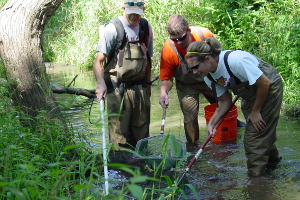Physical Quality (Habitat)
Stream physical character is likely the most overlooked component of stream health. Streams with excellent chemical water quality (no pollution) can still be considered highly degraded as a result of alterations to their physical structure. Pristine streams typically show considerable variability in physical characteristics such as depth, velocity, and substrate (sand, silt, rocks), to name a few. This diversity in basic physical habitat variables translates into biological diversity in stream organisms. Many Iowa streams have been straightened, diked, and channelized for flood control and agricultural purposes and as a result, often lose their physical complexity. Streams that once contained alternating shallow, fast, rocky areas (riffles) and deep, slow pools now resemble ditches, with fairly uniform depth, velocity and substrate. The resulting aquatic community is often dominated by a few tolerant organisms, which have very general habitat requirements. Species with more specific physical habitat needs are often eliminated. Channelization is toward the extreme in physical modification of streams, but all Iowa streams are affected to some degree by physical alterations resulting from human land use. Intensive agriculture and especially urbanization affect the patterns of run-off from watersheds. The effects of which, though not as visible as channelization, may be just as detrimental to stream organisms.
A simple visual evaluation can provide a general picture of stream physical quality but most of the habitat assessments conducted by the Limnology Section actually quantify these physical characteristics to allow comparisons with other streams or the same stream over time. For example, some recent projects involve monitoring the physical/habitat changes in streams resulting from changes in agricultural practices in the watershed. Habitat assessments are typically completed in addition to water chemistry analyses and, especially, biological sampling.




